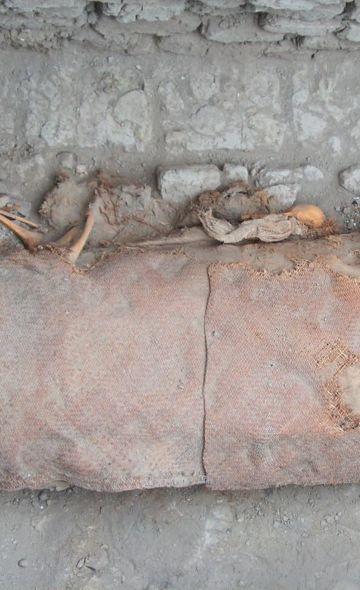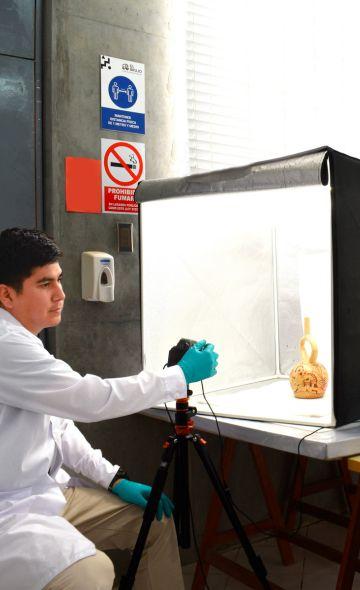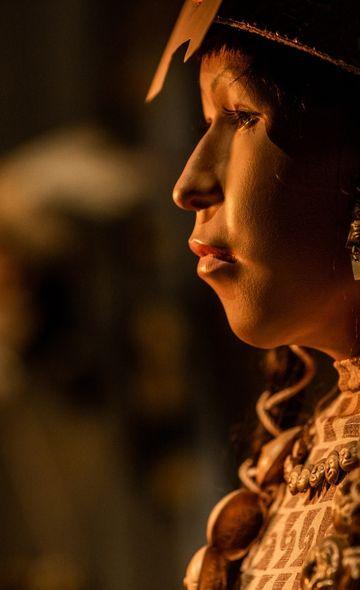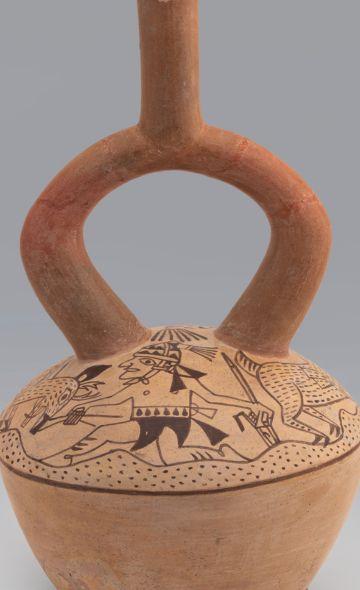- Visitors
- Researchers
- Students
- Community
- Information for the tourist
- Hours and fees
- How to get?
- Visitor Regulations
- Virtual tours
- Classic route
- Mystical route
- Specialized route
- Site museum
- Know the town
- Cultural Spaces
- Cao Museum
- Huaca Cao Viejo
- Huaca Prieta
- Huaca Cortada
- Ceremonial Well
- Walls
- Play at home
- Puzzle
- Trivia
- Memorize
- Crosswords
- Alphabet soup
- Crafts
- Pac-Man Moche
- Workshops and Inventory
- Micro-workshops
- Collections inventory
- News
- Researchers
- Elite sacrifices: The Lady of Cao's female companion
News
CategoriesSelect the category you want to see:
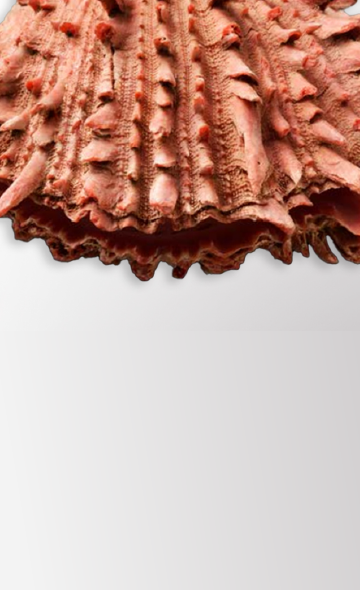
The Use of Spondylus Shells in Moche Ceremonial Contexts: Why Were They Symbols of Status and Wealth? ...
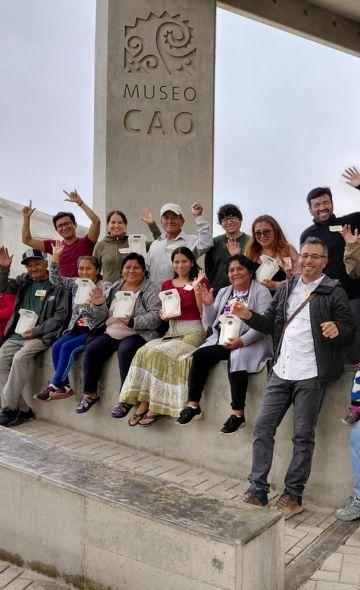
El Brujo Celebrated International Museum Day with Its Community: A Day of Encounter and Cultural Co-Creation ...
To receive new news.
Por: Yuriko García Ortiz y José Alva Chancos
The funerary context of the Lady of Cao
In 2004, the discovery of the burial of an elite figure in the second edifice of Huaca Cao Viejo revealed the social, political and economic complexity of Mochica funerary practices. The location of the funerary context of the Lady of Cao, an unprecedented find in Peruvian archaeology, was defined on its surface by the mouth of a vessel and by the remains of burnings of textiles, gourdes and wooden objects, among others (Franco, 2021; Alva, 2024). Later, after the removal of several levels of adobe filling, wooden beams and stretchers of wild cane, a small chamber was exposed inside the funerary grave, where a huge funerary bundle was found with its trousseau.

Figure 1. Ground drawing of the burial of the Lady of Cao (Franco, 2021: 111).
Female teenager offered to the Lady of Cao
On the right side of the funerary bundle of the Lady of Cao was the skeleton of an adolescent arranged in the lateral ulna with the legs slightly bent (Franco 2021:111). The age of this individual would be between 12 and 15 years, and due to the morphology of the pubic bones and the width of the sciatic notch, it is estimated that it is a female (Verano and Lund 2021:190).
Regarding her death, it is known that the teenager died strangled with a reed rope that was found around her neck (Alva, 2024) and was wrapped in a simple cotton blanket before being buried.

Figure 2. Reed rope around the neck of the sacrificed companion (Verano and Lund 2021:193)
From the physical anthropology results of Verano and Lund (2021), it was determined that the companion had teeth with caries lesions and an abscess in the right lower premolar. This gives more details about her health and the lack of a diet rich in fibers, legumes and vegetables to protect and strengthen the teeth.

Figure 3. Caries and abscess in the lower jaw (Verano and Lund 2021:194).
Ceramics and gourdes: Objects associated with the female companion of the Lady of Cao
The objects associated with the funerary bundle of the Lady of Cao and the body of the adolescent correspond to eleven pieces of pottery and several gourde containers, of which 3 vessels and 1 gourde were found next to the body of the sacrificed female adolescent.

Figure 4. Discovery of the gourde at the feet of the female companion next to the funerary bundle of the Lady of Cao. CAEB photographic archive.
This set of pieces was found in different parts of the body. Por example, at the level of the head of this individual was a pitcher of the modeled vulture style (EBBCE00000-74); while towards the feet was a miniature pitcher with geometric decoration (EBBCE00000-71), very similar to the offerings associated with the funerary bundle of the Lady of Cao, placed on the south side of the tomb. Moreover, next to this last vessel was a cream-colored Mochica stirrup handle bottle with stepped designs (EBBCE00000-75) under the gourde.

Figure 5. Offerings of the female companion of the Lady of Cao.
How common is it to find human sacrifices in Mochica burials?
This type of burial with secondary individuals accompanying the main burial during the Mochica period of the first half of the sixth century AD. is documented in funerary contexts of elite personages. For example, at Huaca Cao Viejo, the first burial chamber tomb excavated in 1998 (tomb 1A/1B) reveals that the main burial was accompanied by a secondary individual and a wide variety of offerings (Franco et al. 1999). Similarly, the graves recorded in the main edifice of Dos Cabezas (Jequetepeque valley) (Donnan, 2007) follow the same pattern.
Additionally, with the passage of time towards the late Mochica, by the seventh century onwards, the tombs became larger and more ostentatious, with more than one companion to the main burial. This is the case of the Lord of Sipán and his 8 companions including men, women and a child (Alva and Donnan 1993) or the so-called priestesses of San José de Moro (Castillo, 2007).
Final comments
In the funerary contexts of the Mochica elite, it is usual to find a special treatment associated with the burial, the trousseau and its location in highly decorated monumental edifices, such as in Huaca Cao Viejo and other religious and political centers of the time.
This recurrence owes to a ceremonial pattern linked to death, where the presence of secondary individuals (often adolescents) accompanying main burials was one of the requirements that aimed to reinforce the hierarchy of the Moche ruling classes, as having the life of a person to accompany the deceased in the tomb is evidence of the marked social asymmetries between the Moche and the power of the aristocracies over other human groups, legitimized by the predominant religious beliefs and discourses.
Currently, in the elite burials of Huaca Cao Viejo we do not know the criteria for selecting the individuals who accompanied the deceased personages, as well as the links between them. In that sense, it will be key to ask the pertinent research questions to delve deeper into the social groups that were also immersed in the performance of funerary rites pertaining to the Moche aristocracies.
References
Alva, J. (2024). The ceramics of El Brujo. Cupisnique and Mochica epochs. Collection Catalog. Fondo de Cultura Económica.
Alva, W., & Donnan, C. B. (1993). Royal Tombs of Sipán. Fowler Museum of Culture History.
Castillo, L. (2007). The Ladies of San José de Moro: Funeral rituals of elite women on the northern coast of Peru. Summa Humanitatis, 1(1), 1-15.
Donnan, C. (2007). Moche Tombs at Dos Cabezas. The Cotsen Institute of Archaeology Press.
Franco, R. (2021). Excavation of burial No. 3 (Lady of Cao). In A. Bazán (Ed.), The funerary context of the Lady of Cao. Finding and research of elite Mochica burials in Huaca Cao Viejo, El Brujo Archaeological Complex (pp. 120-115). Augusto N. Wiese Foundation.
Franco, Régulo G., César Gálvez, and Segundo Vásquez, eds. (1999). Moche Chamber Tombs on the Upper Platform of Huaca Cao Viejo, El Brujo Complex. Lima: Augusto N. Wiese Fundación.
Verano, J., & Lund, M. (2021). Anthropological and paleopathological study of the Lady of Cao and her sacrificed companion (A. Bazán, Ed.; pp. 188-203). Wiese Foundation.
Researchers , outstanding news


